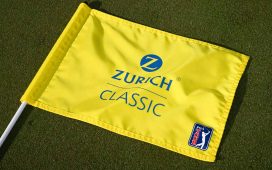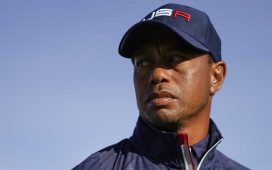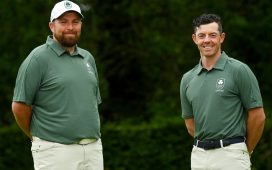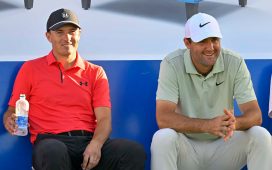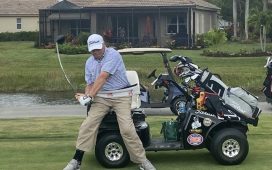Editor’s note: This is the second story in a three-part series.
Just before noon on a February Friday north of Los Angeles, Bryson DeChambeau signed off on his missed cut in the Genesis Invitational at Riviera Country Club and immediately dialed some digits.
“I want to come down, I want to do some work,” he said into his iPhone.
DeChambeau hopped into his car, drove some 115 miles southward and about two hours later was at the Cobra Puma Golf headquarters in Carlsbad.
Meeting him there was Ben Schomin, director of Tour Operations for Cobra Puma Golf who has worked with DeChambeau his entire pro career.
“He was at the indoor hitting bay from 2 until 10,” Schomin said. “Delivered in some pizza for the night, and the next day we did the same thing all over again from 11 to about 9:30 Saturday night. And it was non-stop – tweaking things, moving weight around, testing different heads, theorizing about certain things.
“It got deep.”
DeChambeau knows no other way when pursuing a goal. He stretches his limits as far as he can and leaves himself, as nearly every member of Team DeChambeau will tell you, in a pile of sweat. Be it in the gym, during speed drills where he swings full bore until he can’t go anymore or on the putting green honing his stroke for hours on end, he puts his boundaries to a strenuous test.
“Stopping is not in his personality,” Schomin said. “In speed training sessions where he’s just swinging out of his shoes for an hour, he’s sweating profusely. One time, he said he was starting to get lightheaded, so he said, ‘If I pass out, you’re going to have to catch me.’ ‘Catch you? How am I supposed to catch you when you’re swinging a driver at 142 mph? What do you want me to do?’ So, there was a point where he literally had to get down on a knee because he was getting lightheaded. What he’s doing is different and it’s working.”
Since DeChambeau became Bison Bryson by adding 40 pounds to his already large mass last spring – with most of the poundage piling up during the 13-week quarantine the PGA Tour was forced to take because of the global pandemic – he’s turned golf on its head and won three PGA Tour titles, including the 2020 U.S. Open and the 2021 Arnold Palmer Invitational two weeks after he missed the cut in LA.
Much has been made about his ball speed, swing speed, single-length irons. But his work ethic involving both his body and mind deserves equal notice.
“His work ethic is not forced. It’s super natural to him. He wants to be out there working as long as he does,” said Chris Como, DeChambeau’s swing coach. “I don’t know how you stop someone with that energy. Now, there are times I’m in his ear, ‘You’re good, you’re good,’ and sometimes he’ll listen to me.
“But he’ll go, sometimes, ‘OK, one more ball.’ And we’ll go another hour.
“I really enjoy trying to figure something out, so to partner with someone as talented as he is and has the work ethic he does and we share the same amount of curiosity, willing to explore things to get better, allows me to channel my talents and go down rabbit holes with him.”
Still, DeChambeau had to take his work ethic up a notch or two or three when he befriended Kyle Berkshire, the long-drive king who can make DeChambeau feel small on the course. This guy’s stock yardages include 360 yards for his driver, 315 yards for his 3-iron, 240 yards for his 6-iron, 205 yards for his 8-iron, 165 yards for his pitching wedge.
There’s long and then there’s Berkshire long.
“Bryson’s probably the only person I ran into who is willing to push to where I would push my speed sessions,” Berkshire said. “He can typically hit 300 balls in one speed session, and he’d hit a number, let’s just say, 138 clubhead speed after 100 balls. After that I would tell him I want him to hit 144 and the next two hours would be filled with doing everything we can trying to get him riled up and get him into a good head space where he’s really pushing himself.
“Every single session ends with him in a puddle of sweat.”
Berkshire was the one who talked DeChambeau into taking himself to the edge, pushing himself to the brink of blacking out. And Berkshire said there’s a lot left in DeChambeau’s tank to tap into.
“I was a little scared to do it,” DeChambeau said. “First time I tried it I was very cautious with it. I was dead tired and he told me I was only 50 percent done. He kept pushing me. And when I nearly passed out, he said, ‘OK, you’re done.’
“But that was when I hit my max ball speed.”
Taking his body to the max comes with its aches and pains, which DeChambeau knows all too well. Just watching him violently swing or go all out in a workout can make you hurt.
“I hope we continue to see a healthy Bryson,” said Dottie Pepper, former LPGA Tour star and one of the game’s best on-course analysts. “It takes a lot of effort and he’s hitting so many balls so hard the ground eventually hits back.”
DeChambeau has talked about how painfully sore he’s felt after brutal workouts and admitted he has to go easier on his body, thus he’s working on different ways to inherently have a faster motion without huge speed-training sessions.
“There was a point in time when I started this early on and I tried to get to 190 ball speed, I remember, there were times where I’m swinging literally out of my butt, and I was like, ‘Man, this is not good for my body. I can’t do this,’” he said. “I remember waking up of the next day, I’m like, dude, my hands, everything hurt. What am I doing? There were numerous times I felt like I had to backtrack for a bit.”
But as dangerous as what DeChambeau is doing looks to be, he’s confident all is safe.
That’s where conditioning coach Greg Roskopf comes in. The founder of Muscle Activation Techniques (MAT) based in Denver, who has consulted with various professional sports teams including the NFL’s Denver Broncos and the NBA’s Denver Nuggets and Utah Jazz, has worked with DeChambeau for four years to improve his mechanics and optimize his muscle function.
“The MAT process and methods look at the neuromuscular system specifically and how it is designed to relieve pain and improve mobility,” Roskopf said. “The foundational concepts behind MAT recognize that whenever you have stress, trauma or overuse to the muscles, the resultant inflammation alters the communication between the nervous system and the muscular system.
“It’s like having loose battery cables, with the brain as the battery, the nervous system as the cables and the muscles as the engine. The nervous system sends the information to the muscles, but the information does not get to the muscles as efficiently as it should. As a result, this altered communication impedes the ability for the muscles to contract efficiently. When muscles can’t contract efficiently, they can’t do their job to stabilize joints and protect the body from injury. And when the muscles can’t shorten effectively, the opposite muscles tighten up as a protective mechanism.
“We identify where the altered communication pathways are within the body and through a very specific hands-on stimulation technique, we ‘tighten the battery cables.’ This activation technique improves the communication between the nervous system and the muscle system. Through the improvement of the communication pathways, the muscles are able to contract more efficiently and then are better equipped to stabilize joints and protect the body from injury.
“The muscles actually get stronger on the spot.”
The goal of DeChambeau’s exercise program developed by Roskopf is to increase his strength throughout his body, movement by movement, muscle by muscle.
“All of this, working off the concept that when we put great amounts of force on the body, like Bryson does in his golf swing, we’re only as strong as our weakest link,” Roskopf said. “It is those weak links that eventually set us up for injury.
“But Bryson has not only gotten stronger but has actually been able to double his force output capabilities in all of the muscles in his body.”
Golf Channel analyst Brandel Chamblee doesn’t think DeChambeau’s swing will lead to injury.
“Hardly. The people who injure themselves, like Brooks Koepka and Jason Day, are resisters with the lower body. And because they resist, they have to be explosive in transition,” Chamblee said. “Bryson doesn’t generate power like that. He turns his hips fully and releases fully. He’s not likely to hurt himself.
“Bryson didn’t metaphorically reach higher, he literally reached higher. He got his hands farther up, he extended his right leg, and he drew down in transition. He let his hands fall down close to his shoulder, thereby creating more moment of inertia. Like a skater when they draw their arms in, they spin faster. If they leave their arms out, they will spin slower. Bryson incorporated nearly every power principle you can imagine. He was willing take the risk and he’s reaping the rewards through science and hard work.”
